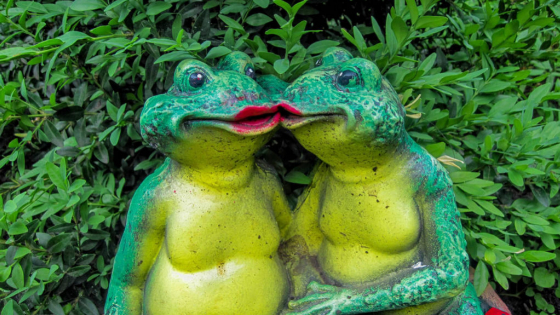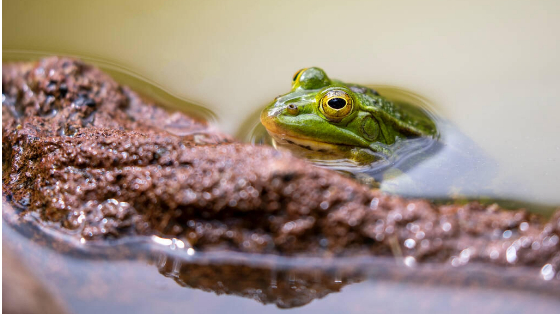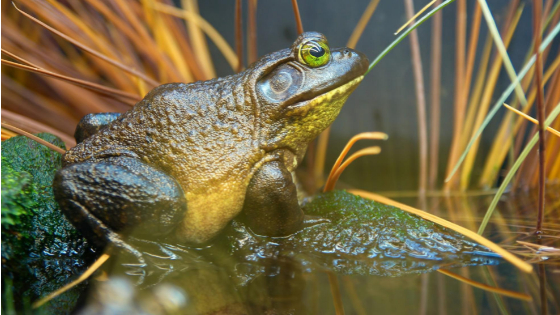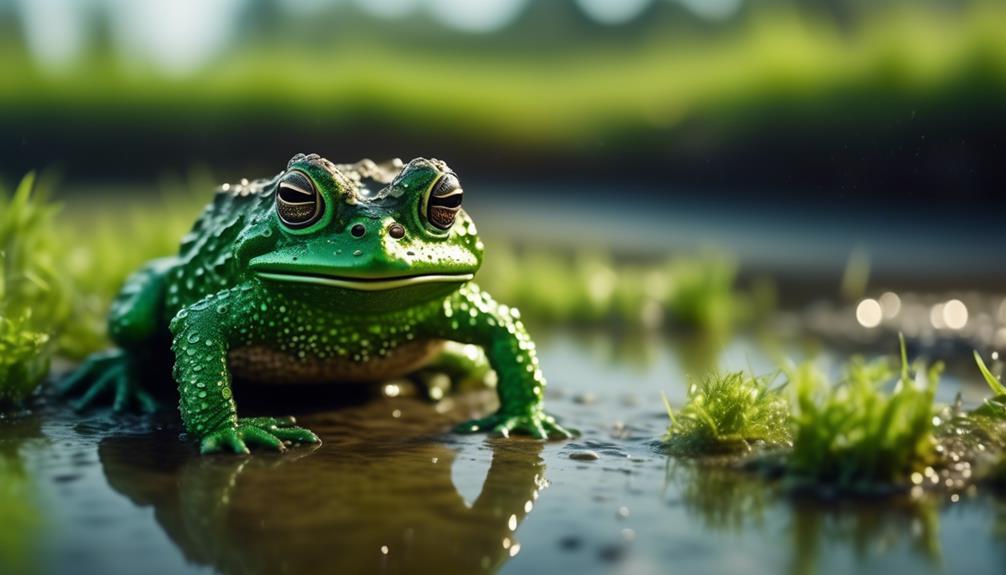
In a world where numerous species are grappling with the threat of extinction, the Natterjack toad stands as a resilient fighter, battling for its very existence. With its striking yellow stripe and unique behavioral traits, this amphibian has carved a niche for itself in specific habitats.
But as we delve into the challenges it faces, from habitat loss to pollution, we begin to understand the urgency of its fight. The Natterjack toad’s survival story is one that demands our attention and raises questions about the fragility of our ecosystems.
Will conservation efforts be enough to turn the tide in favor of this endangered species?
Key Takeaways
- Natterjack toads have a lifespan of up to 15 years and primarily feed on insects, especially beetles.
- They inhabit open terrain with sparse vegetation and their tracks can be seen in loose sand.
- Natterjack toads reproduce by laying strings of eggs in shallow, warm pools and rely on mating calls to find each other.
- The species is at risk due to threats such as habitat loss, deterioration of lowland heaths, reduction in coast habitats, and acidification of aquatic habitat.
Life History of Natterjack Toads
The life history of Natterjack toads encompasses their lifespan, feeding habits, movement patterns, and reproductive behavior. These toads have a lifespan of up to 15 years.
They primarily feed on insects, with a preference for beetles.
Natterjack toads are nocturnal and are commonly found in open terrain with sparse vegetation. Their movement can be observed through their tracks in loose sand. They have the ability to colonize new habitats quickly by covering considerable distances each night.
In terms of reproduction, Natterjack toads spawn between the end of April and July. They lay strings of eggs in shallow, warm pools, which require a slight slope and sparse vegetation. Mating calls play a crucial role in helping the sexes find each other. The extended mating period helps compensate for the risk of tadpoles dying when pools dry out.
Reproduction and Mating Behavior
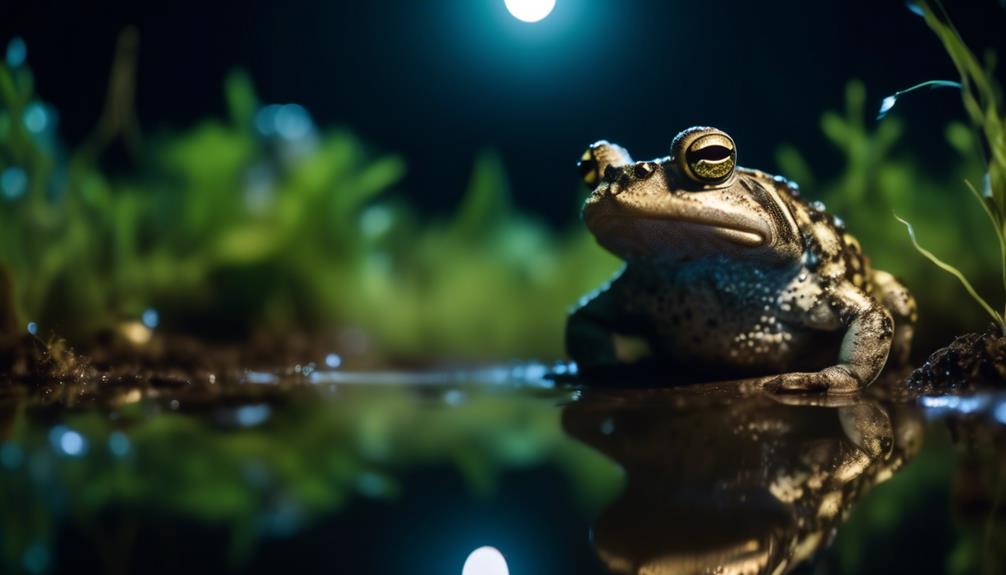
Reproduction and mating behavior of Natterjack toads involve specific behaviors and adaptations to ensure successful breeding. Here are four key points regarding their reproduction and mating behavior:
- Breeding Season: Natterjack toads spawn between the end of April and July, during which time they lay strings of eggs in shallow, warm pools. This specific breeding season allows for optimal conditions for the development of their offspring.
- Mating Calls: Mating calls play a crucial role in the reproductive process. These calls help the males attract females and ensure successful mating. The distinctive and loud calls of the males can be heard during the breeding season.
- Habitat Requirements: The pools where Natterjack toads lay their eggs need to have a slight slope and sparse vegetation on the banks and in the water. These specific habitat requirements ensure the survival of their offspring and provide suitable conditions for successful breeding.
- Extended Mating Period: Natterjack toads engage in mating over an extended period. This strategy helps compensate for the risk of pools drying out, which could lead to the death of their tadpoles. By breeding over a longer period, they increase the chances of successful reproduction and ensure the survival of their species.
Distribution of Natterjack Toad Populations
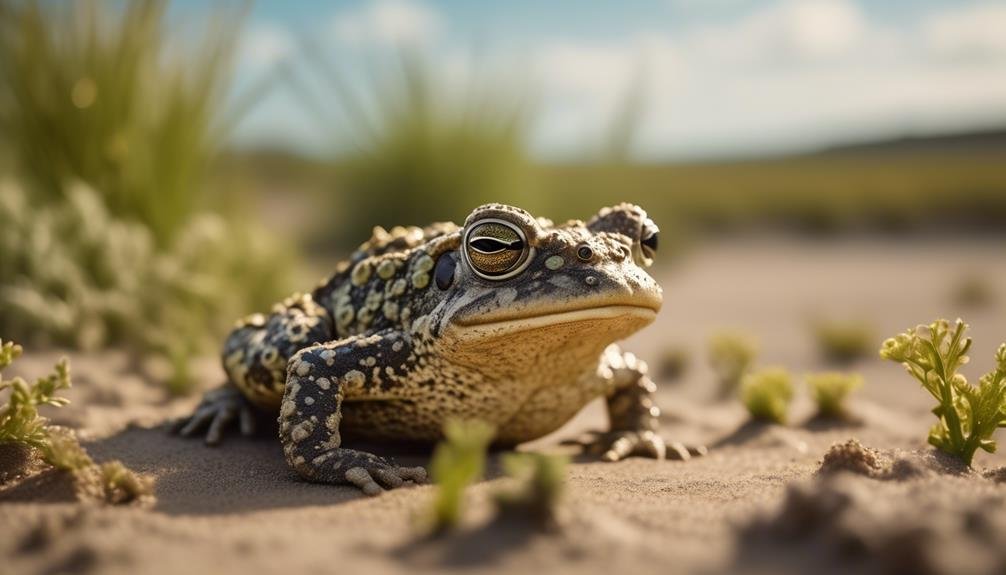
The distribution of Natterjack toad populations spans across 17 European countries, with a particular concentration in the southern part of their range. In the UK, they are primarily found in coastal sites, while in Ireland, they are the only native toad species and can be found in County Kerry and County Wexford. In mainland Europe, they inhabit various habitats inland.
Natterjack toads are known for their ability to colonize new habitats quickly by moving considerable distances each night. However, their populations face threats due to habitat loss, deterioration of lowland heaths, and reduction in habitable coast. Acidification of aquatic habitat from acid rain and pollution is also a concern.
Efforts are being made to protect their habitats and reverse the decline in their populations.
Conservation Efforts in the UK
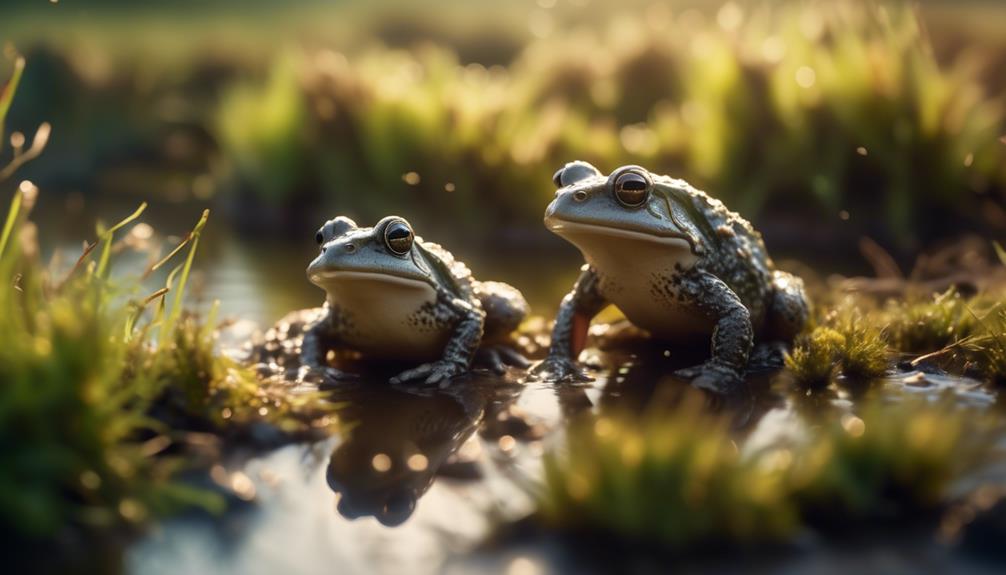
What measures are being taken to conserve the Natterjack toad population in the UK? Conservation efforts in the UK are crucial for the survival of the endangered Natterjack toad. Here are four key measures that are being taken:
- Habitat protection: National nature reserves in England safeguard the sand dune habitats where Natterjack toads reside. These reserves help prevent habitat loss and degradation, ensuring a suitable environment for the toads.
- Restoration of lowland heaths: Deterioration of lowland heaths poses a threat to the Natterjack toad population. Conservation initiatives focus on restoring and maintaining these habitats, providing the toads with essential breeding and foraging grounds.
- Reduction of coastal habitat loss: The reduction of habitable coastlines is a significant concern. Efforts are being made to protect and manage coastal areas, ensuring that the necessary habitats for the toads are preserved.
- Addressing pollution and acidification: Acid rain and pollution can lead to the acidification of aquatic habitats, negatively impacting the Natterjack toads. Measures are being taken to reduce pollution levels and mitigate the effects of acid rain, safeguarding the toads’ aquatic environment.
These conservation efforts aim to protect the Natterjack toad population in the UK, ensuring their survival for future generations.
Threats to Natterjack Toad Population
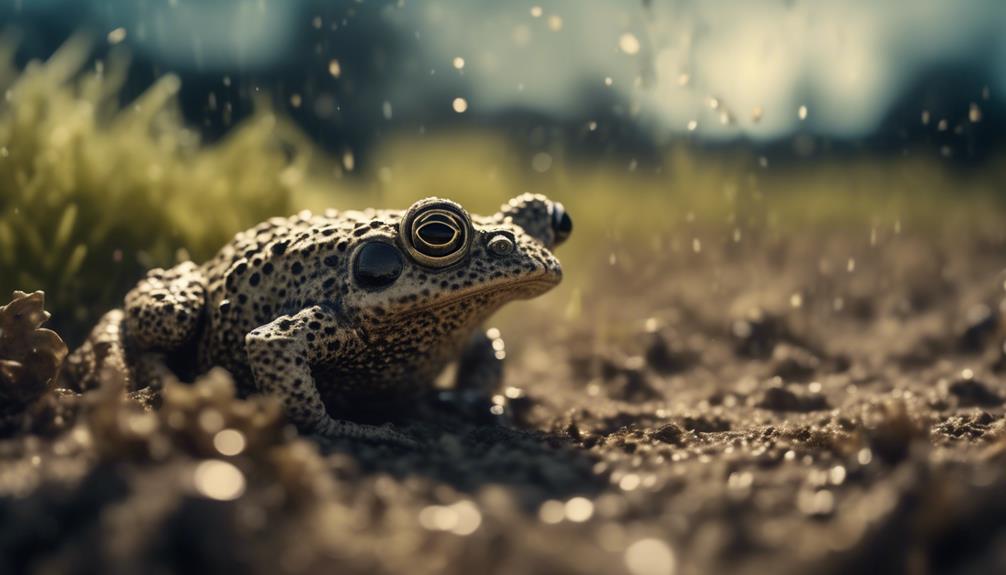
Natterjack toad populations face significant threats that endanger their survival and require immediate conservation efforts. The table below highlights three major threats to the natterjack toad population:
| Threats | Description |
|---|---|
| Habitat Loss | The destruction and degradation of the natterjack toad’s natural habitat, including lowland heaths and coastal areas, result in the loss of suitable breeding and foraging grounds. |
| Pollution | Acidification of aquatic habitats caused by acid rain and pollution poses a serious threat to the natterjack toad population. This can lead to the decline of their prey species and affect their reproductive success. |
| Climate Change | Rising temperatures, changes in precipitation patterns, and sea-level rise associated with climate change can negatively impact the natterjack toad’s habitat and alter their breeding patterns, potentially leading to population declines. |
These threats highlight the urgent need for conservation efforts to protect and restore the natterjack toad population. Measures such as habitat preservation, pollution control, and climate change mitigation are crucial to ensure the survival of this endangered species.
Importance of Habitats for Natterjack Toads
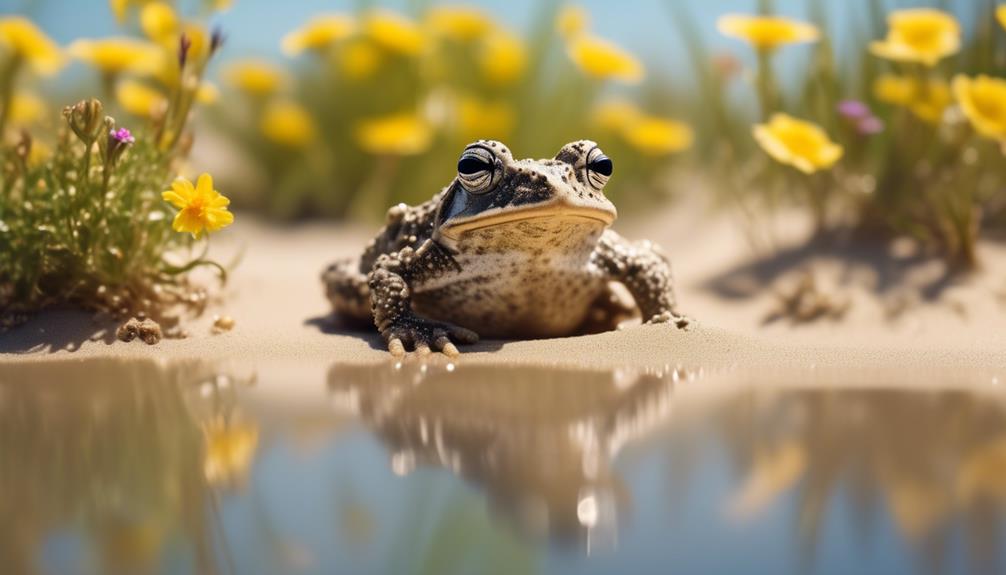
Habitat quality plays a crucial role in the survival and conservation of natterjack toads. Here are four reasons why habitats are important for these endangered amphibians:
1) Breeding grounds: Natterjack toads require specific conditions to lay their eggs. Shallow, warm pools with a slight slope and sparse vegetation provide the ideal environment for successful reproduction.
2) Food sources: These toads mainly feed on insects, especially beetles. Habitats with diverse insect populations ensure an adequate food supply for the toads, supporting their growth and survival.
3) Movement and colonization: Natterjack toads are known to move considerable distances each night. Habitats with open terrain and sparse vegetation facilitate their movement, allowing them to explore new areas and colonize new habitats.
4) Protection from threats: High-quality habitats provide natural protection for natterjack toads. Habitats with intact vegetation and suitable microclimates offer shelter from predators and adverse environmental conditions.
Conserving and protecting habitats is vital for ensuring the long-term survival of natterjack toads and maintaining the delicate balance of their ecosystems.
Acidification and Pollution Concerns
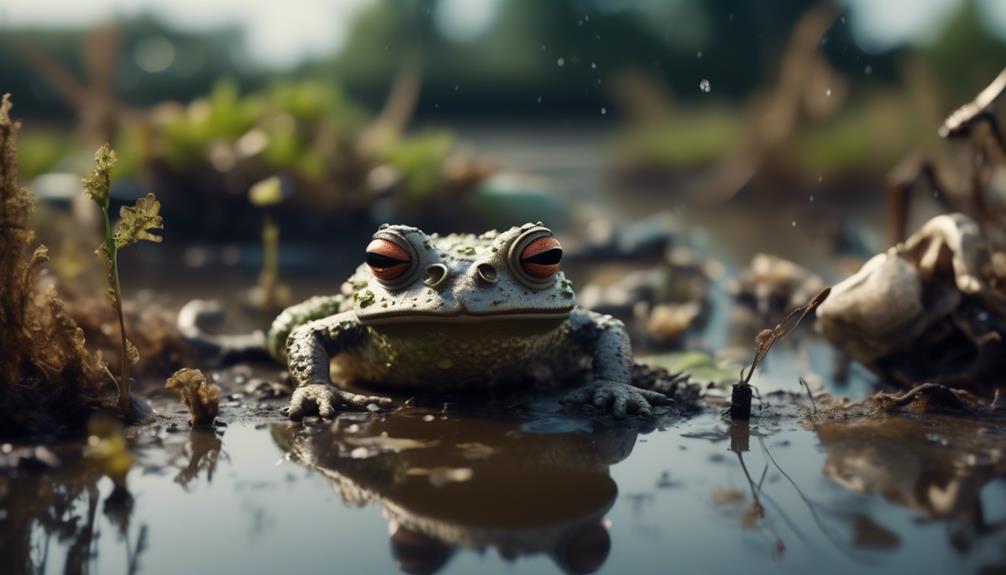
Acidification and pollution pose significant concerns for the conservation and survival of natterjack toads. These amphibians are highly sensitive to changes in water quality, particularly the pH levels and chemical composition of their aquatic habitats.
Acid rain, resulting from air pollution, can lead to the acidification of water bodies, creating an inhospitable environment for natterjack toads and their eggs.
Additionally, pollution from agricultural runoff, industrial waste, and urban development can introduce harmful chemicals into their habitats, affecting their reproductive success, immune system, and overall health.
These threats further exacerbate the challenges faced by natterjack toads, including habitat loss and reduction in suitable coastal areas.
To ensure the survival of these endangered toads, it is crucial to address and mitigate the impacts of acidification and pollution on their fragile ecosystems.
Conservation Efforts in Ireland
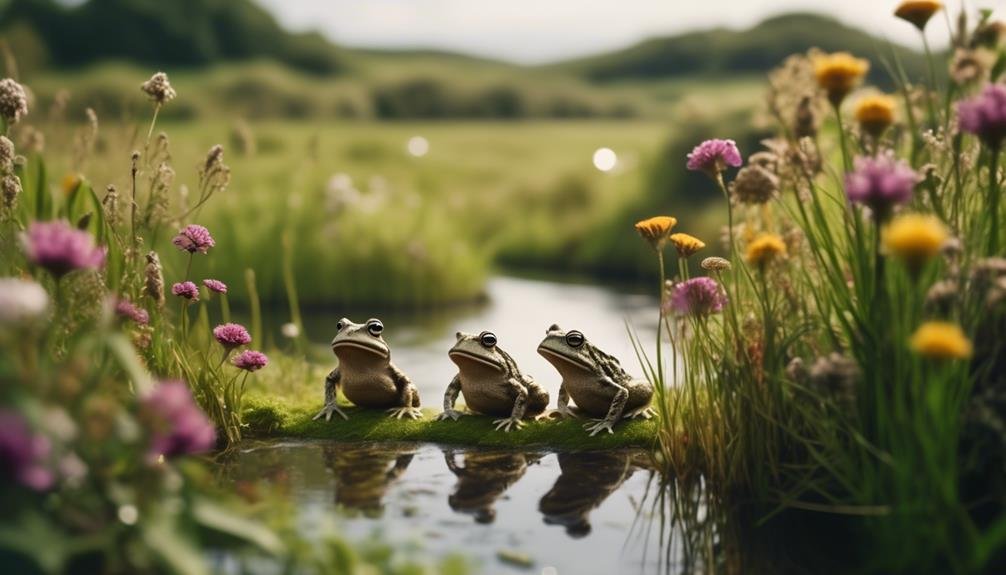
Given the significant threats posed by acidification and pollution to the survival of natterjack toads, concerted conservation efforts have been implemented in Ireland to safeguard the future of this endangered species. These efforts include:
- Creation of Ponds: The National Parks and Wildlife Service has taken proactive measures to reverse habitat loss by creating ponds specifically for the natterjack toads. These ponds provide suitable breeding and feeding grounds for the species.
- Release of Toadlets: A collaborative project between Fota Wildlife Park and the National Parks and Wildlife Service has resulted in the release of 6,000 toadlets into their natural range in County Kerry. This initiative aims to boost the population and enhance the species’ chances of survival.
- Symbolic Representation: The natterjack toad has been adopted as a symbol for Dooks Golf Club in Kerry, raising awareness about the conservation efforts and the need to protect the species.
- Conservation Priority: Recognizing the importance of preserving this unique amphibian, the natterjack toad is considered a conservation priority in Ireland. This designation highlights the ongoing commitment to ensuring the long-term survival of the species.
Natterjack Toads as a Conservation Priority
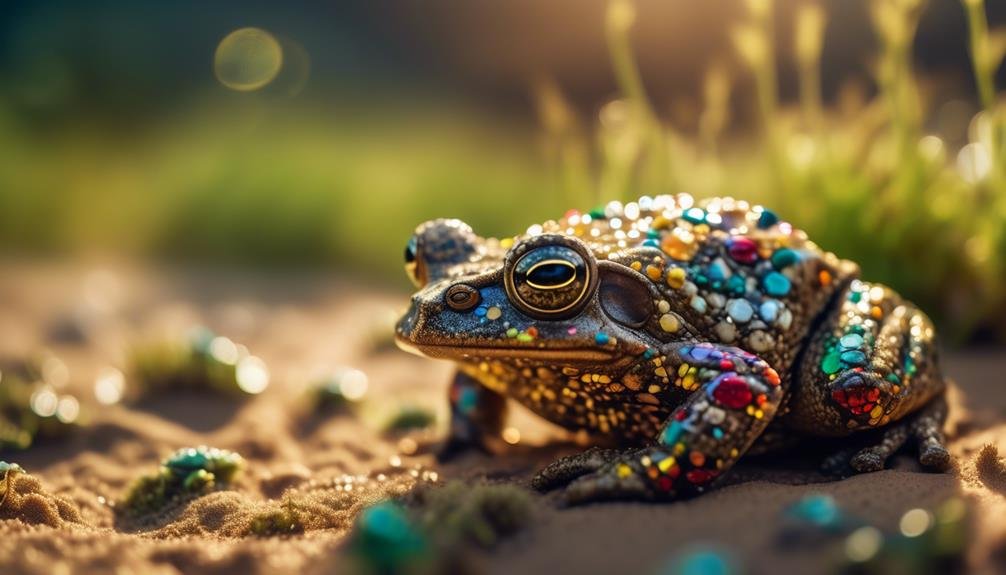
Recognizing the urgent need to protect and preserve the endangered natterjack toads, they have been designated as a conservation priority in Ireland. The National Parks and Wildlife Service has taken significant steps to ensure the survival of this species.
One of their initiatives involves creating ponds specifically for the natterjack toads, which helps reverse the loss of their natural habitat. Additionally, a collaborative project between Fota Wildlife Park and the National Parks and Wildlife Service has successfully released 6,000 toadlets into their natural range in County Kerry.
This concerted effort highlights the importance placed on the conservation of these toads in Ireland. By prioritizing their protection, it is hoped that the population of natterjack toads will recover and thrive in their native habitat.
Success Stories: Reintroduction Projects
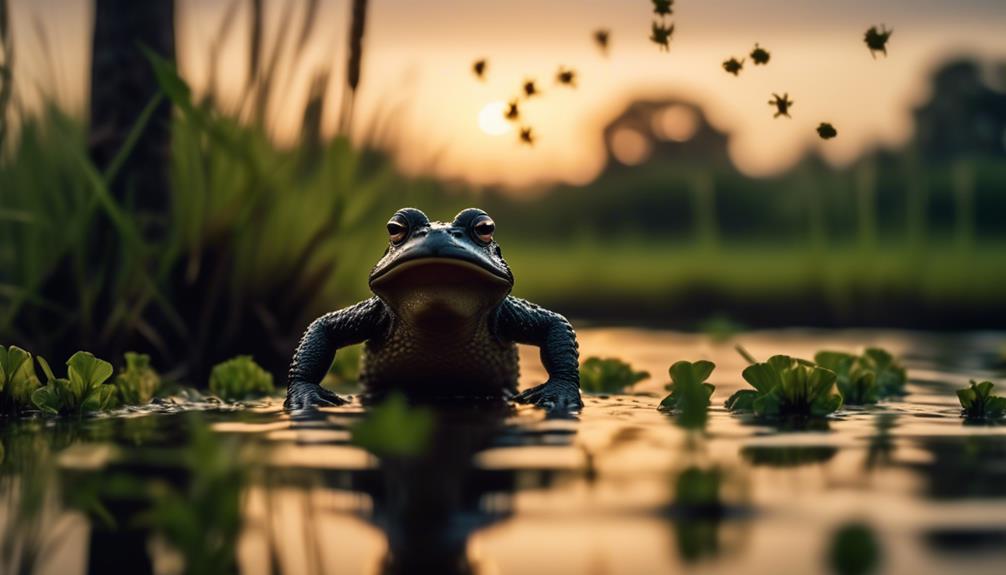
One notable achievement in the conservation efforts for the endangered natterjack toads is the successful implementation of reintroduction projects. These projects have played a crucial role in restoring and expanding the population of this species.
Here are four examples of successful reintroduction projects:
- Fota Wildlife Park, Ireland: Fota Wildlife Park, in collaboration with the National Parks and Wildlife Service, released 6,000 toadlets into their natural range in County Kerry. This project aims to reverse habitat loss and ensure the survival of the natterjack toads in Ireland.
- Brecklands, England: Reintroduction efforts in the Brecklands region of England have focused on restoring lowland heath habitats, which are essential for the toad’s survival. These initiatives have led to the successful establishment of new populations in this area.
- Dune restoration, Wales: Reintroduction projects in Wales have focused on restoring sand dune habitats, which are crucial for the natterjack toads. By creating suitable breeding grounds and protecting these habitats, populations have been able to thrive.
- Captive breeding programs: Several zoos and conservation organizations have implemented captive breeding programs to boost the population of natterjack toads. These programs ensure genetic diversity and provide a safeguard against potential population declines.
These reintroduction projects demonstrate the effectiveness of targeted conservation efforts in saving the endangered natterjack toad from extinction.
Frequently Asked Questions
What Is the Average Lifespan of a Natterjack Toad?
The average lifespan of a Natterjack toad is up to 15 years. They are protected amphibians in the UK and are considered endangered in Ireland, facing threats such as habitat loss and acidification of aquatic habitat.
What Do Natterjack Toads Eat Besides Insects?
Natterjack toads primarily feed on insects, especially beetles. Their diet consists mainly of invertebrates found in their habitat. They are not known to consume any other types of food besides insects.
How Do Natterjack Toads Locate Each Other for Mating?
Natterjack toads locate each other for mating through their mating calls, which are crucial in helping the sexes find each other. These calls serve as a means of communication and enable successful reproduction in suitable habitats.
What Are the Main Threats to the Natterjack Toad Population in the Uk?
The main threats to the Natterjack toad population in the UK include loss of habitat, deterioration of lowland heaths, reduction in habitable coast, and acidification of aquatic habitat from acid rain and pollution.
How Many Natterjack Toad Reintroduction Projects Have Been Successful in Ireland?
There have been successful natterjack toad reintroduction projects in Ireland, including one involving Fota Wildlife Park and the National Parks and Wildlife Service, where 6,000 toadlets were released into their natural range in County Kerry.
How Can Endangered Natterjack Toads Be Protected from Invasive Species Like the Madagascar Toad?
Endangered natterjack toads can be protected from invasive species like the Madagascar toad by implementing strict monitoring and control measures. These efforts are necessary to prevent the spread of invasive toad threatens biodiversity and ensure the survival of the natterjack toad population.
Conclusion
In conclusion, the Natterjack toad, an endangered species, faces numerous challenges to its survival including habitat loss, deterioration of lowland heaths, and pollution.
Conservation efforts are crucial in protecting and restoring their habitats in both the UK and Ireland.
The Natterjack toad’s unique life history, reproductive behaviors, and ability to colonize new habitats make it a conservation priority.
Continued efforts and success stories, such as reintroduction projects, are essential for the long-term survival of this species.

